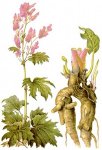Rhubarb
Rheum tanguticum Maxim.
Botanical characteristics. The family is buckwheat. Perennial herbaceous plant with a juicy upright, furrowed, hollow inside a stem up to 2.5 m high. Numerous fleshy roots leave the powerful short rhizome. Leaves are large, regular, radical - five- and seven-bladed, stem-ovoid. Small whitish pink or red flowers are collected in numerous paniculate inflorescences. Blossoms in the third year of life in June-July. Fruit is a trihedral nut, ripens in July-August.
Spread. In the wild we do not meet. Cultivated in the middle zone of Russia, in the Baltics, in Ukraine, in Siberia as a medicinal, food and ornamental plant.
Used parts of the plant.
Roots with rhizomes.
In the roots and rhizomes of the plant antraglycosides (up to 6%) and their free aglikones (reumemodine, chrysophonol, rhein, etc.), tar, tanoglycosides (up to 10%), rutin, organic acids and catechins were found.
Application.
It is based on the strong laxative effect of the plant. In addition, the rhubarb is anti-inflammatory, antiseptic, choleretic, carminative, fortifying and astringent.
The laxative effect of rhubarb is caused by anthraglikosides, which, 8 to 10 hours after ingestion of large doses, increase the peristalsis of the large intestine. Tanoglycosides, which are part of the rhubarb, have an astringent and antiseptic effect. When small doses are administered, tanoglycosides are shown, and the rhubarb has an astringent, fixing effect.
It is believed that the rhubarb acts more effectively on children and young people, and people elderly, suffering from chronic constipation and hemorrhoids, it is not shown.
Usually rhubarb is prescribed for spastic constipation, intestinal atony, rectal cracks and hemorrhoids, as well as for constipation in pregnant women.
The effectiveness of drugs with prolonged use is reduced.
Preparation.
Preparations from the rhubarb root are let in by the pharmaceutical industry and sold in pharmacies.
Rhubarb tablets at 0.3-0.5 g. Assign 2-3 tablets per reception - to relax the stool.
Rhubarb extract is dry. Assign 0.1 to 1 g per reception (depending on age).
Rhubarb powder is prescribed to adults for 0.5-2 g per reception, children - 0.1 g and above, depending on the age.
In homeopathy Rheum 2x, 3x, 3 is used with chronic enterocolitis, accompanied not by liquid, but by mushy excrements - dark with an admixture of mucus, with a sour smell. A characteristic symptom: flatulence and aching pains in front of a chair. Rheum is more effective in the treatment of sick children and adolescents; On action on the nervous system is similar to Chamomilla and Belladonna. Assign it to children also with chorea, facial tics, restless sleep.





Comments
Commenting on, remember that the content and tone of your message can hurt the feelings of real people, show respect and tolerance to your interlocutors even if you do not share their opinion, your behavior in the conditions of freedom of expression and anonymity provided by the Internet, changes Not only virtual, but also the real world. All comments are hidden from the index, spam is controlled.